How to Change Render Engine in Blender
Blender, as a powerful 3D modeling and rendering software, offers multiple rendering engines for users to choose from, each with its unique features and applicable scenarios. This article will guide you on how to change the render engine in Blender to meet your various needs.
1. Open Blender Software
Firstly, make sure you have opened the Blender software and loaded the scene or model you want to render.
2. Access Render Engine Settings
In the top menu bar of the Blender interface, you can find an option called "Render Engine." Click on this option to open a dropdown menu listing all the rendering engines supported by Blender.

3. Select Render Engine
In the dropdown menu, you'll see different render engine options such as "Cycles," "Eevee," "Workbench," and more. Depending on your requirements, select the appropriate render engine. Below are brief introductions to several commonly used render engines:
Cycles: Cycles is Blender's high-quality rendering engine suitable for rendering both still images and animations. It supports global illumination, refraction, transparency, and other effects.
Eevee: Eevee is Blender's real-time rendering engine designed for scenarios requiring quick previews and interactive rendering. It renders fast but with slightly lower accuracy compared to Cycles.
Workbench: Workbench is Blender's fast rendering engine used for quickly creating sketches and previewing models. It lacks lighting and shadow effects.
4. Adjust Render Settings (Optional)
After selecting the render engine, you can optionally adjust the render settings based on your needs. Different render engines may have different parameters and options. You can tweak settings such as lighting, sampling rate, render resolution, etc., according to your scene requirements.
5. Start Rendering
Once you've chosen the render engine and adjusted the settings (if necessary), you can click the "Render" button at the bottom of the Blender interface to start rendering your scene or model. Depending on the render engine and settings you've selected, Blender will automatically render and generate the final image or animation.
By following these steps, you can easily change the render engine in Blender and adjust render settings as needed to achieve satisfactory rendering results. If you need high-quality 3D textures, HDRI, or 3D model downloads while creating models and virtual scenes, you can download them from Relebook and directly import textures and 3D models into your project for use.

